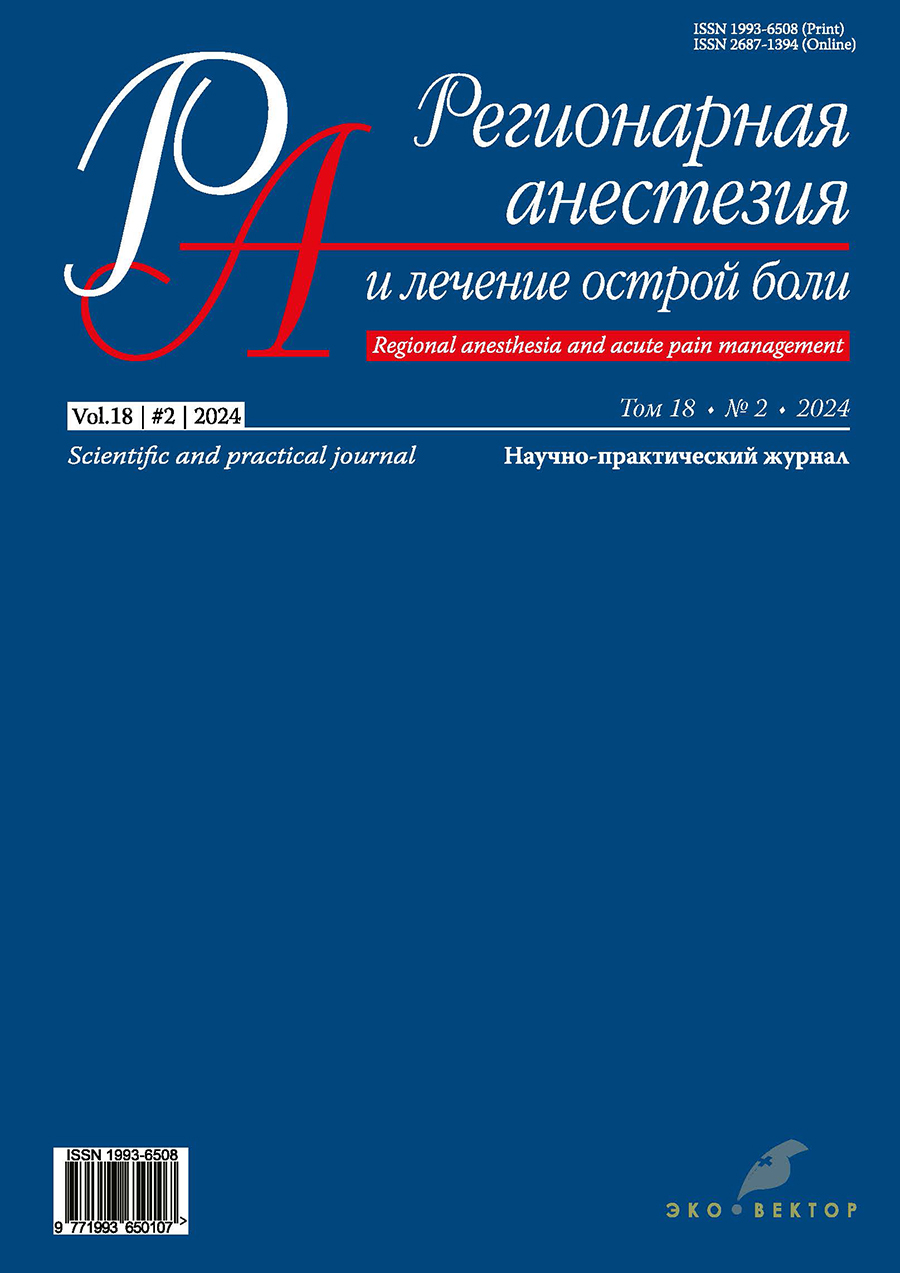Optimization of ultrasound navigation techniques for brachial plexus block using proximal subclavian access
- Authors: Tsvetkov V.G.1, Lakhin R.E.1, Polezhankin E.V.1, Chartorizhsky E.V.1, Tsygankov K.A.1
-
Affiliations:
- Kirov Military Medical Academy
- Issue: Vol 18, No 2 (2024)
- Pages: 133-141
- Section: Original study articles
- Submitted: 06.03.2024
- Accepted: 06.06.2024
- Published: 01.08.2024
- URL: https://rjraap.com/1993-6508/article/view/628810
- DOI: https://doi.org/10.17816/RA628810
- ID: 628810
Cite item
Abstract
BACKGROUND: When performing a brachial plexus block in the proximal subclavian region, the scanning plane is located deeper and posterior to the clavicle midpoint. Data on the angle of the ultrasound probe and visualization of the brachial plexus bundles are limited.
AIM: Our aim was to evaluate visualization and positioning of the neurovascular bundle in the infraclavicular region for proximal brachial plexus block..
MATERIALS AND METHODS: Volunteer patients (добровольцах (n=28, median — 43 years)) at the Military Traumatology and Orthopedics Clinic of the Military Medical Academy, named after S.M. Kirov, were studied. Ultrasound navigation was used to evaluate the neurovascular bundle followed by brachial plexus block.
RESULTS: The study showed that the brachial plexus bundle is best visualized at an average sensor angle of between 90° and the maximum that allows visualization of at least one of the elements of the brachial plexus 64.4° (65.7°, 63°) and amounted to 77.5° (77.9°, 76.5°).
CONCLUSION: The optimal angle for performing a brachial plexus block using the proximal subclavian approach is 77.5°. Optimal visualization of the brachial plexus is possible in the angle range from 64.4° to 90°, which enables selecting the safest trajectory of the needle when performing a blockade in this area, considering the anatomical characteristics of the patient. Further studies are required to compare the sensor angles used in actual clinical practice to the angles obtained in this study.
Full Text
About the authors
Vasily G. Tsvetkov
Kirov Military Medical Academy
Author for correspondence.
Email: vasilii_cvetkov@mail.ru
ORCID iD: 0000-0003-4980-597X
SPIN-code: 5316-4617
Russian Federation, St. Petersburg
Roman E. Lakhin
Kirov Military Medical Academy
Email: doctor-lahin@yandex.ru
ORCID iD: 0000-0001-6819-9691
SPIN-code: 7261-9985
MD, Dr. Sci. (Med.), Associate Professor
Russian Federation, St. PetersburgEvgeniy V. Polezhankin
Kirov Military Medical Academy
Email: vasilii_cvetkov@mail.ru
ORCID iD: 0009-0007-6311-1698
Russian Federation, St. Petersburg
Evgeniy V. Chartorizhsky
Kirov Military Medical Academy
Email: chev89@mail.ru
ORCID iD: 0000-0002-9684-9783
SPIN-code: 8909-1230
Russian Federation, St. Petersburg
Kirill A. Tsygankov
Kirov Military Medical Academy
Email: doctorcygankov@mail.ru
ORCID iD: 0000-0002-2357-0685
SPIN-code: 7133-0503
MD, Cand. Sci. (Med.)
Russian Federation, St. PetersburgReferences
- Koryachkin VA, Zabolotsky DV. Place of regional blocks in surgical anesthesia. Medicine: Theory and practice. 2018;3(4):65–69. EDN: YZPBLV
- Ovechkin AM, Bayalieva AZh, Ezhevskaya AA, et al. Postoperative pain relief. Clinical recommendations. Bulletin of Intensive Care named after A.I. Saltanov. 2019;(4):9–33. doi: 10.21320/1818-474X-2019-4-9-33
- Zabolotsky DV, Ulrich GE, Malashenko NS, Kulev AG. Ultrasound in the hands of an anesthesiologist — exclusive or routine? Regional anesthesia and treatment of acute pain. 2012;6(1):5–10. EDN: RPKKST
- Ovechkin AM, Politov ME, Morozov DV. Neurological complications of regional anesthesia. Regional anesthesia and treatment of acute pain. 2018;12(1):6–14. doi: 10.18821/1993-6508-2018-12-1-6-14
- Nadeau MJ, Lévesque S, Dion N. Ultrasound-guided regional anesthesia for upper limb surgery. Can J Anaesth. 2013;60(3):304–320. doi: 10.1007/s12630-012-9874-6
- Koryachkin VA. Peripheral nerve blocks and ultrasound navigation. Regional anesthesia and treatment of acute pain. 2020;14(1):4–5. doi: 10.17816/1993-6508-2020-14-1-4-5
- Zabolotsky DV, Malashenko NS, Mankov AV. Ultrasound navigation of invasive manipulations in anesthesiology. Siberian Medical Journal (Irkutsk). 2012;113(6):15–20. EDN: PFFBQH
- Lakhin RE, Koryachkin VA, Uvarov DN, et al. Intensive therapy with systemic toxicity of local anesthetics. Perioperative fasting in adults and children (clinical recommendations). Togliatti Medical Consilium. 2017;(1): 8–36. EDN: ZNLYJH
- Aliste J, Bravo D, Layera S, et al. Randomized comparison between interscalene and costoclavicular blocks for arthroscopic shoulder surgery. Reg Anesth Pain Med. 2019:rapm-2018-100055. Epub ahead of print. doi: 10.1136/rapm-2018-100055
- Karmakar MK, Sala-Blanch X, Songthamwat B, et al. Benefits of the costoclavicular space for ultrasound-guided infraclavicular brachial plexus block: description of a costoclavicular approach. Reg Anesth Pain Med. 2015;40(3):287–288. doi: 10.1097/AAP.0000000000000232
- Demondion X, Herbinet P, Boutry N, et al. Sonographic mapping of the normal brachial plexus. AJNR Am J Neuroradiol. 2003;24(7):1303–1309.
- Sala-Blanch X, Reina MA, Pangthipampai P, et al. Anatomic Basis for Brachial Plexus Block at the Costoclavicular Space: A Cadaver Anatomic Study. Reg Anesth Pain Med. 2016;41(3):387–391. doi: 10.1097/AAP.0000000000000393
- Zabolotsky DV, Koryachkin VA. Child and regional anesthesia — why? Where? And How? Regional anesthesia and treatment of acute pain. 2016;10(4):243–253. doi: 10.18821/1993-6508-2016-10-4-243-253
- Zabolotsky DV, Koryachkin VA, Ulrich GE. Postoperative analgesia in children. Are there methods available today? (current state of the problem). Regional anesthesia and treatment of acute pain. 2017;11(2):64–72. doi: 10.18821/1993-6508-2017-11-2-64-72
Supplementary files











